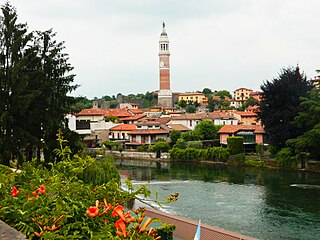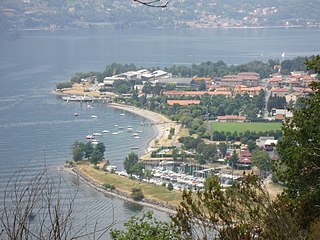
Refrancore is a village and comune in the northwestern Italian province of Asti in the Piedmont region, located some 13 kilometres (8 mi) east of Asti in the Basso Monferrato. The territory of the comune extends over an area of 13.15 square kilometres (5.08 sq mi) and is largely devoted to agriculture, in particular to vineyards growing the Grignolino and Barbera wine grapes.

Caccamo is a town and comune located on the Tyrrhenian coast of Sicily in the Metropolitan City of Palermo.

Iseo is a town and comune in the province of Brescia, in Lombardy, Italy, on the south shore of Lake Iseo. It is bounded by the communes of Provaglio d'Iseo, Sulzano, Polaveno and Paratico.

Manerba del Garda is a town and comune in the province of Brescia, in Lombardy. It is located at the southwest side of the Lake Garda.

Monte Isola is a town and comune in the province of Brescia, in Lombardy.

Palazzolo sull'Oglio is a city and comune in the Province of Brescia, in the region of Lombardy in northern Italy. It is located south of Lake Iseo, bordering the Province of Bergamo, and has a population of 20,208. It is the fifth largest city in the Province, after Brescia, Desenzano del Garda, Montichiari and Lumezzane.

Pisogne is a comune of 8156 inhabitants in the province of Brescia, in Lombardy, Italy.

Rovato is a comune in the province of Brescia, in Lombardy, northern Italy. Neighbouring towns are Coccaglio, Erbusco and Cazzago San Martino. It is located in the Franciacorta hills, 11 km south of Lake Iseo and 18 km west of Brescia.

The territory of Franciacorta, literally short France, is a section of the Province of Brescia in the Italian Region of Lombardy. Franciacorta extends from Mount Orfano on the southwest area to the shores of Lake Iseo, and from the river Oglio on the western border to the city of Brescia in the east. The geography of rolling hills was shaped by glacial action. The soil, glacial moraines consisting of gravel and sand over limestone, drains well, and is ideal for the cultivation of grapes and winemaking. The weather is mild and constant due to its location south of the foothills of the Alps and the tempering presence of large lakes. To publicize enotourism the district established a Strada del Vino Franciacorta on the model of the famed German Wine Route (Weinstraße) in 2001.

Lovere is a town and comune in the province of Bergamo, in Lombardy, northern Italy, at the northwest end of Lake Iseo.

Monsummano Terme is an comune located in the Province of Pistoia, Tuscany, central Italy. It is located in the Valdinievole, and is a popular spa resort.

Atessa is an municipality in the province of Chieti, Abruzzo, south-eastern Italy. It is part of the Val di Sangro mountain community. It is the largest municipality in the province by extension and eighth by population.

Bisenti is a town and comune in Teramo province in the Abruzzo region of southern Italy.

Roseto Valfortore is a small town and comune of the Province of Foggia, in the Apulia Region of southeastern Italy.

San Paolo d'Argon is a comune (municipality) of 5,721 inhabitants in the Province of Bergamo in the Italian region of Lombardy, located about 60 kilometres (37 mi) northeast of Milan and about 11 kilometres (7 mi) east of Bergamo. The commune is located at the beginning of the Cavallina Valley and it's crossed by two main roads: the Strada Statale 42 del Tonale e della Mendola and the Provincial Road 91 to the Lake Iseo.

Sambuca di Sicilia is a comune (municipality) in the Province of Agrigento in the Italian region Sicily, located about 68 kilometres (42 mi) southwest of Palermo and about 89 kilometres (55 mi) northwest of Agrigento.

Dervio is a comune (municipality) in the Province of Lecco in the Italian region Lombardy, located on the eastern shore of Lake Como, about 70 kilometres (43 mi) north of Milan and about 25 kilometres (16 mi) northwest of Lecco. It is located on a peninsula with same name on the Lake Como, at the mouth of the Varrone river Valley.

Franciacorta[frantʃaˈkorta] is a sparkling wine from the Province of Brescia (Lombardy) with DOCG status produced from grapes grown within the boundaries of the territory of Franciacorta, on the hills located between the southern shore of Lake Iseo and the city of Brescia. It was awarded DOC status in 1967, the designation then also including red and white still wines. Since 1995 the DOCG classification has applied exclusively to the sparkling wines of the area.

Brescia is a city and comune in the region of Lombardy in northern Italy. It is situated at the foot of the Alps, a few kilometres from the lakes Garda and Iseo. With a population of more than 200,000, it is the second largest city in the region and the fourth of northwest Italy. The urban area of Brescia extends beyond the administrative city limits and has a population of 672,822, while over 1.5 million people live in its metropolitan area. The city is the administrative capital of the Province of Brescia, one of the largest in Italy, with over 1,200,000 inhabitants.
























